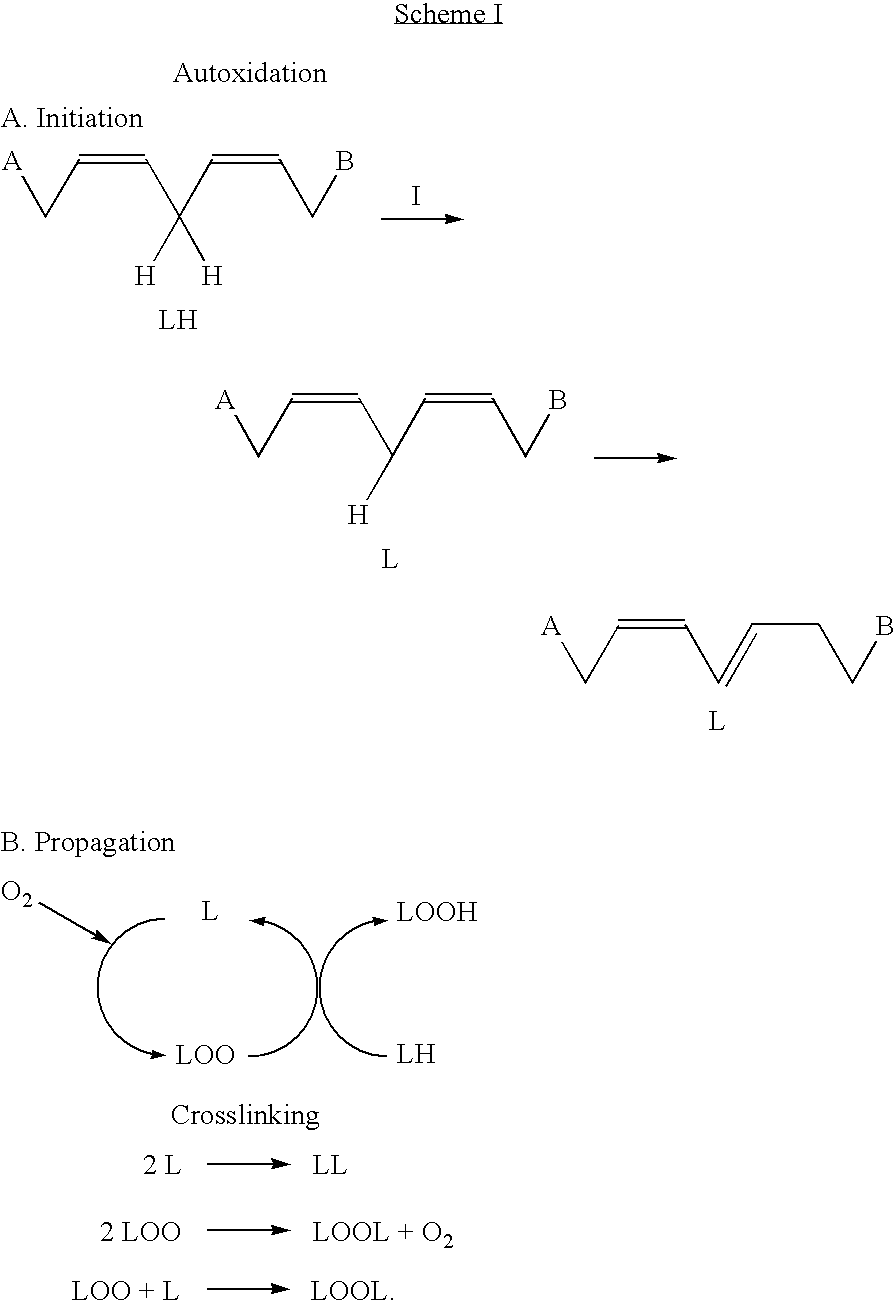Drier for air-drying coatings
a technology of air-drying coating and air-drying coating, which is applied in the field of air-drying coatings, can solve the problems of reducing the catalytic activity of cobalt carboxylate in air-drying coatings, limiting the use of iron as active element, and only applying in darker coloured finishes, etc., and achieves the effect of reducing biomolecules
- Summary
- Abstract
- Description
- Claims
- Application Information
AI Technical Summary
Problems solved by technology
Method used
Image
Examples
example 1
[0071] A standard commercial coating composition, DSM WB paint based on URADIL AZ 554 Z-50, was combined with the siccatives (0.1 wt. % metal based on the amount of URADIL AZ 554 Z-50 binder) according to the series described in Table I. In the experiment 1, only catalyst is added (Co based), in experiments 2-5 catalyst and reducing biomolecule, i.e. the drier according to the present invention, is added, and in experiment 6 no catalyst is added. In the cases in which the drier according to the present invention was added, the added amount was kept constant, but the molar ratio of metal to ascorbic acid was varied.
TABLE IDrying of a commercial coating composition: DSM WB paint based onURADIL AZ 554 Z-50B.K.recorderMolarBy hand(10° C.; 25%ratioBraive recorder(23° C.; 50% RH)RH)metal / (23° C.; 50% RH)(hours)(hours)Ascorbic(hours)SurfaceThroughTotalExp.CatalystacidStage aStage bStage cdrydrydry1WEB Co 6—0.04—±51.00±4.006.302Fe** / AsA*1 / 20.070.473.400.30±4.003.153Fe** / AsA*1 / 40.080.503.5...
example 2
[0073] A commercial alkyd emulsion, URADIL AZ 516 Z-60, was mixed with the catalyst (combination) consisting of the metal salt (0.07 wt. % metal based on solid binder) and the reducing biomolecule ascorbic acid. The resulting mixture was applied with a 60 μm film applicator on glass plates. The results of the drying tests (B.K. recorder; Königs hardness) are summarised in table III.
TABLE IIIDrying tests of a commercial alkyd emulsion: URADIL AZ 516 Z-60König hardnessMolar ratioB.K. recorderat 23° C.metal / Ascorbic(23° C.)(seconds)Exp.Catalystacid (AsA)(total dry; hours)(after 20 h)1WEB Co 6—5.49.82Fe / AsA1 / 28.88.43Fe / AsA1 / 46.09.84Fe / AsA1 / 69.28.45No catalyst—>24—
example 3
[0074] A commercial solvent-borne alkyd resin, Uralac AD43 W-70 (70 wt. % in white spirit), was mixed with the catalyst (combination) consisting of the metal salt (0.07 wt. % metal based on solid binder) and the reducing biomolecule ascorbyl palmitate—added as a 10 wt. % solution in butoxyethanol. The resulting mixture was applied with a 60 μm film applicator on glass plates. The results of the drying tests (B.K. recorder; Königs hardness) are summarised in table III.
TABLE IVDrying tests of a commercial solvent-borne alkyd resin: Uralac AD43 W-70Molar ratio Fe / B.K. recorderKönig hardness at 23° C.Ascorbyl(23° C.)(seconds)Exp.CatalystPalmitate(total dry; hours)20 hrs43 hrs164 hrs1Nuodex Fe 10— >24— 8.415.43Nuodex Fe 10 / 1 / 48-109.815.824.3*AscorbylPalmitate5No catalyst—>>24——11.2
*Addition of ascorbyl palmitate gave rise to a considerable reduction of the colour of the film.
PUM
| Property | Measurement | Unit |
|---|---|---|
| molar ratio | aaaaa | aaaaa |
| molar ratio | aaaaa | aaaaa |
| temperatures | aaaaa | aaaaa |
Abstract
Description
Claims
Application Information
 Login to View More
Login to View More - R&D
- Intellectual Property
- Life Sciences
- Materials
- Tech Scout
- Unparalleled Data Quality
- Higher Quality Content
- 60% Fewer Hallucinations
Browse by: Latest US Patents, China's latest patents, Technical Efficacy Thesaurus, Application Domain, Technology Topic, Popular Technical Reports.
© 2025 PatSnap. All rights reserved.Legal|Privacy policy|Modern Slavery Act Transparency Statement|Sitemap|About US| Contact US: help@patsnap.com

